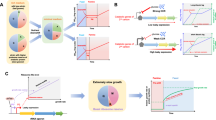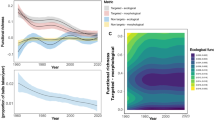Abstract
Space has been demonstrated repeatedly to be a limiting resource to sessile suspension-feeding invertebrates1–7,15, whereas the question of whether food resources are ever limiting has long been a controversial topic8,9. On the basis of previous research and in the virtual absence of any mechanistic understanding, it is commonly assumed that interactions can be interpreted as competition for spatial resources alone. This assumption is clearly unacceptable. Whereas a mobile organism might feed in one location rich in prey, spawn in another safe from predators of its young, and hide in yet another inaccessible to its own predator, a sessile organism cannot separate, spatially or temporally, its demands for food to eat and space on which to live. For the sessile organism, access to food implies access to space and vice versa. Consequently, the empirical observation of competition for space does not justify the assumption that competition for food is unimportant. I report here that competition for food among suspension feeders can occur and may, in fact, provide a mechanism by which sessile organisms compete for space.
This is a preview of subscription content, access via your institution
Access options
Subscribe to this journal
Receive 51 print issues and online access
$199.00 per year
only $3.90 per issue
Buy this article
- Purchase on Springer Link
- Instant access to full article PDF
Prices may be subject to local taxes which are calculated during checkout
Similar content being viewed by others
References
Buss, L. W. & Jackson, J. B. C. Am. Nat. 113, 223–234 (1979).
Connell, J. H. Ecology 42, 710–723 (1961).
Dayton, P. K. Ecol. Monogr. 41, 351–389 (1971).
Knight-Jones, E. W. & Moyse, J. Symp. Soc. exp. Biol. 15, 72–95 (1962).
Lang, J. C. Bull. mar. Sci. 23, 260–279 (1973).
Paine, R. Y. Oecolog. 15, 93–120 (1975).
Stebbing, A. R. D. J. mar. biol. Ass. U.K. 53, 247–261 (1973).
Levinton, J. Am. Nat. 106, 472–486 (1972).
Pütter, A. F. Z. allg. Physiol. 16, 65–114 (1914).
Jackson, J. B. C. Am. Nat. 111, 743–767 (1977); in Biology and Systematics of Colonial Organisms (eds Larwood, G. & Rosen, B.) 499–555 (Academic, London, 1979).
Ryland, J. S. Bryozoans (Hutchinson University Library, London, 1970).
Silén, L. in Biology of Bryozoa (eds Woollacott, R. M. & Zimmer, R. L.) 184–232 (Academic, New York, 1977).
Bryan, P. G. Micronesica 9, 237–242 (1973).
Buss, L. W. in Aspects of Sponge Biology (eds Harrison, F. W. & Cowden, R. R.) 315–328 (Academic, New York, 1976).
Jackson, J. B. C. & Buss, L. W. Proc. natn. Acad. Sci. U.S.A. 72, 5160–5163 (1975).
Chiba, Y. & Kàto, M. Sci. Rep. Tôhoko Univ. 32, 201–206 (1966).
Connell, J. H. Ecology 42, 710–723 (1961).
Lang, J. C. Bull. mar. Sci. 23, 260–279 (1973).
Stebbing, A. R. D. J. mar. biol. Ass. U.K. 53, 247–261 (1973).
Miller, R. S. Adv. Ecol. Res. 4, 1–74 (1967).
Reidl, R. & Forstner, H. Sarsia 34, 163–188 (1968).
Winston, J. E. in Biology of Bryozoa (eds Woollacott, R. M. & Zimmer, R. L.) 233–271 (Academic, New York, 1977); Bull. mar. Sci. 28, 1–31 (1977).
Bishop, J. W. & Barr, L. M. in Animal Colonies (eds Boardman, R. S., Cheetam, A. H. & Oliver, W.A.) 433–438 (Dowden, Hutchinson & Ross, Pennsylvania, 1973).
Crisp, D. J. Nature 178, 1076 (1956).
Author information
Authors and Affiliations
Rights and permissions
About this article
Cite this article
Buss, L. Bryozoan overgrowth interactions—the interdependence of competition for space and food. Nature 281, 475–477 (1979). https://doi.org/10.1038/281475a0
Received:
Accepted:
Issue Date:
DOI: https://doi.org/10.1038/281475a0
This article is cited by
-
Biotic resistance or invasional meltdown? Diversity reduces invasibility but not exotic dominance in southern California epibenthic communities
Biological Invasions (2023)
-
1 °C warming increases spatial competition frequency and complexity in Antarctic marine macrofauna
Communications Biology (2021)
-
Interactions between coral propagules in aquarium and field conditions
Scientific Reports (2020)
-
Unraveling interactions: do temperature and competition with native species affect the performance of the non-indigenous sun coral Tubastraea coccinea?
Coral Reefs (2020)
-
Differential resource use in filter-feeding marine invertebrates
Oecologia (2020)
Comments
By submitting a comment you agree to abide by our Terms and Community Guidelines. If you find something abusive or that does not comply with our terms or guidelines please flag it as inappropriate.



